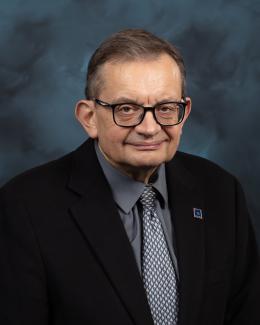The discovery of element 117—tennessine, as it has been provisionally named—was made possible by a collaboration of researchers in the United States and Russia. ORNL provided the radioisotope berkelium-249, which was bombarded with a beam of calcium-48 at Russia's Joint Institute for Nuclear Research in Dubna until atoms of element 117 appeared.
The achievement was a long time coming. As the stars aligned in 2009 toward the search for the theorized element, ORNL's Jim Roberto knew he needed someone to help manage what would certainly be a complex international effort. The discovery of this synthetic element was going to be a race against time.
Roberto, who helped organize the international search, asked the Physics Division's Krzysztof Rykaczewski to work behind the scenes to make sure the Russian team had everything it needed from ORNL to run the experiment.
“It's good to have a nuclear spectroscopist on the team,” says Rykaczewski, an American Physical Society fellow and veteran of nuclear decay spectroscopy research at ORNL's Holifield Radioactive Ion Beam Facility.
It was good because the Holifield studies have identified about 10 new alpha and proton radioactive nuclei and led to the investigation of “superheavies”—exotic radioactive nuclei packed with protons and neutrons and often very short-lived. The experience ORNL and University of Tennessee physicists gained in studying even shorter-lived alpha and proton decays of exotic nuclei provided the Russian experiment with much insight into superheavies' behavior and detection.
“We knew perfectly what was involved because of our earlier discoveries of new alpha emitters and proton emitters in experiments at the Holifield Facility,” Rykaczewski says.
The superheavies also hold clues to the “island of stability,” even heavier isotopes that now exist only in theory. Rykaczewski deems progress toward these long-lived synthetic nuclei more important than adding elements to the periodic table, because they could open new realms of physics and chemistry.
Rykaczewski oversaw the development of detectors and instruments loaned to the Russian facility. But ORNL's key contribution to the project was the production and delivery of 22 milligrams of the isotope berkelium-249, a byproduct of the production of californium-252, for which ORNL is one of the world's only sources.
The most nerve-wracking part of the element-117 discovery was getting the berkelium-249 to Dubna under an oppressive time constraint.
Berkelium-249 has a 330-day half-life. That's nearly a year, but the radioisotope has to decay three months after emerging from ORNL's High Flux Isotope Reactor before it can be processed. Then come three months of chemical separations. Half the year ticks away up front before it's ready to fly to Russia.
Under Rykaczewski's watch, the radioisotope was carefully packaged, divided into five heavily shielded parcels and documented. Airline pilots have to approve their cargo, however, and the first pilot balked. After a week, another pilot agreed to take it on board.
“I am happy,” Rykaczewski remembers.
His happiness, like the superheavies, was short-lived. A day later the package was back in New York. There was an oversight, it seems.
“The cargo was marked by all labels known to man as dangerous goods, and it arrived in Moscow without any shipping papers,” he says.
No matter. Two days later it flew the Atlantic again, and a day later it was again back in New York. “We were expecting a fax before the plane arrived” was the reason offered by dutiful officials at the destination airport.
Third time’s a charm: The shipment, replete with fax, was accepted.
“Then some junior official kept it for a week, just to show us. All the time it's decaying. This was my life in 2009,” Rykaczewski says.
The precious shipment finally arrived at the Research Institute of Atomic Reactors at Dmitrovgrad, where the berkelium-249 was hand-painted onto a target. From there it traveled to JINR. Six months of continuous bombardment and data acquisition yielded a half-dozen atoms of element 117. Follow-up experiments confirmed the discovery.
“The Russians were impressed by the purity of the berkelium samples,” Rykaczewski says. “ORNL’s High Flux Isotope Reactor irradiated the seed material, and our Radiochemical Engineering Development Center contributed the processing, and it was just really great work.”



